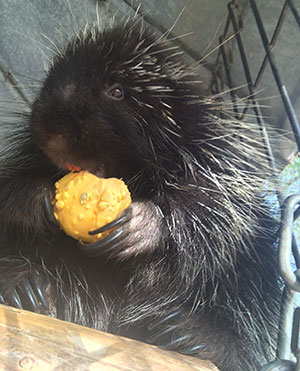
Dermatophytosis – An Overview For Veterinary Technicians
By Christine Hackworth, RVT
|
|
|
|
Figure 1. Sydney the porcupine enjoys a treat at Manhattans's Sunset Zoo. Sydney was brought into the Veterinary Health Center at Kansas State University with a skin condition that was successfully treated by the clinical staff. |
Dermatophytosis should be suspected in animals showing lesions of alopecia, erythema, papules, scaling, or crusting1,2,7 (Figure 1, courtesy of the Sunset Zoo). Remaining hairs may appear as stubble or broken.2,7 Common locations of dermatophyte lesions include the head, ears, and front limbs.7 The diagnosis of dermatophytosis is typically made by conventional techniques including trichography, fungal culture, and histopathology.1-3,5,7 Use of the ultraviolet Wood's lamp may reveal the presence of pathogenic dermatophytes (M. canis).1,2,5 A trichogram examines hairs under the microscope. The shafts and roots of the hair can be evaluated for spores or hyphae if fungus is present. Fungal culture is considered the most sensitive technique for the identification of dermatophytes.1 If fungal growth is observed on the culture media, the genus and species of the fungal organism can then be further identified microscopically.1,2,5 Positive fungal hyphae identification also enables the clinician to consider the likely source of the dermatophyte for subsequent control and protection of in-contact animals.1,2 Histopathology can help determine whether a fungal organism recovered in culture represents contamination, colonization or true infection.3 However, histopathology usually cannot identify the fungal genus and species, which are vital for specific diagnosis and treatment.3
Dermatophytosis is often a self-limiting disease with spontaneous resolution.1,2 However, medical therapy is typically warranted in order to successfully treat the animal and decrease the zoonotic potential of the disease.1,2,6,7 Treatment for dermatophytosis usually entails a multimodal approach and can include topical and/or systemic antifungal medications, environmental decontamination, and careful hair clipping.2,4,5,7 Dermatophytosis may be treated with a variety of topical and systemic antifungal medications.1,2,5,7 For mild cases such as superficial, focal areas of infection, a cream or ointment can be applied to the affected areas. Prevention must be taken so that the animal does not lick off the medication.7 For animals that resist the application of topical medication or have a severe infection such as widespread, expanding lesions or deep infections accompanied by furunculosis, oral medications can be used. Treatment is typically recommended until at least two consecutive negative fungal cultures are obtained at 1–2-week intervals.5
For a dermatophytosis case treated at the Veterinary Health Center in a porcupine, see this recent publication8 or the press release at http://www.k-state.edu/today/announcement.php?id=35631.
Christine graduated in 1999 from KSU with a Bachelors of Science in Life Science and in 2011 graduated with Associate of Applied Science degree from Penn Foster. She presently is a RVT in the Exotic and Dermatology sections of the Veterinary Health Center at the Kansas State College of Veterinary Medicine.
References
- Bond R. Superficial veterinary mycoses. Clinics of Dermatology. 2010; 28:226-236.
- Dermatophytosis [Internet]. The Center for Food Security and Public Health; c2013 [cited 28 March 2016]. Available from: http://www.cfsph.iastate.edu/ Factsheets/pdfs/ dermatophytosis.pdf
- Guarner J, Brandt ME. Histopathologic diagnosis of fungal infections in the 21st century. Clinical Microbiology Reviews. 2011;24(2):247-280.
- Janssen DL. Guidelines for the management of zoonotic diseases. In: Miller RE, Fowler ME (eds.). Fowler's zoo and wild animal medicine current therapy. 8th ed. St. Louis (MO): Elsevier Saunders; 2015. p. 733-734.
- Moriello KA, DeBoer DJ. Treatment of dermatophytosis. In: Bonagura JD, Twedt DC (eds.) Kirk's Current Veterinary Therapy XV. St. Louis, (MO): Elsevier; 2014. p. 449-451.
- Phair K, Larsen RS, Wack R. Dermatophytosis (Trichophyton mentagrophytes) in a Coquerel's Sifaka (Propithecus coquereli). Journal of Zoo and Wildlife Medicine. 2001;42(4): 759–762.
- Pollock C. Fungal diseases of laboratory rodents. The Veterinary Clinics of North America: Exotic Animal Practice. 2003;6:401-413.
- Hackworth CE, Eshar D, Nau M, Bagladi-Swanson M, Andrews GA, Carpenter JW. Diagnosis and successful treatment of a potentially zoonotic dermatophytosis caused by Microsporum gypseum in a zoo-housed North American porcupine (Erethizon dorsatum). Journal of Zoo and Wildlife Medicine. 2017;48(2): 549-553.
Next Article: 3 Easy Steps For Submitting Companion Animal Core Vaccine Panels
Return to Index
